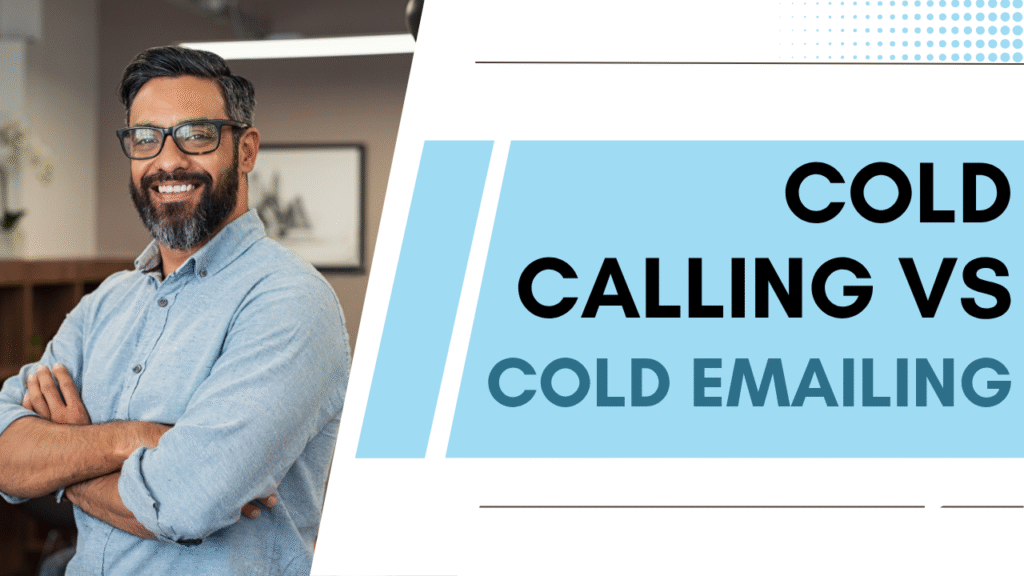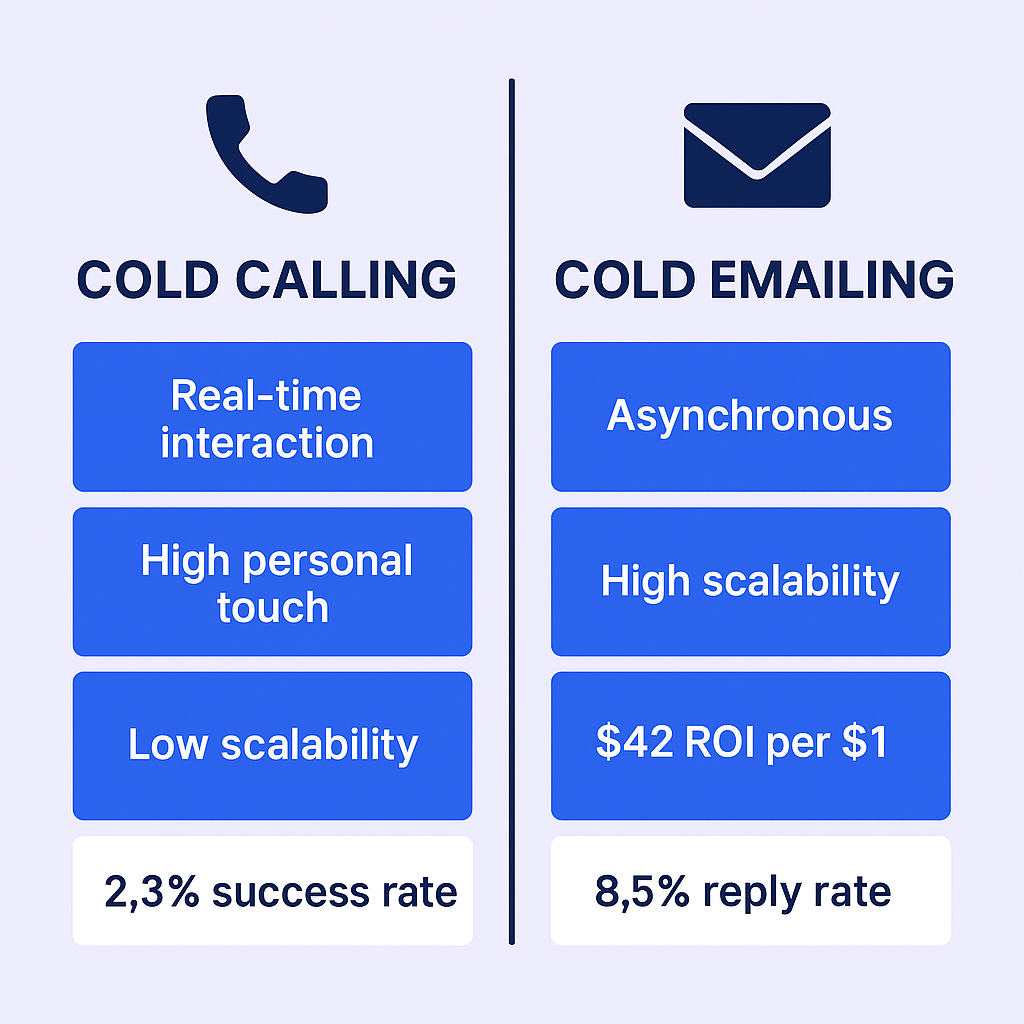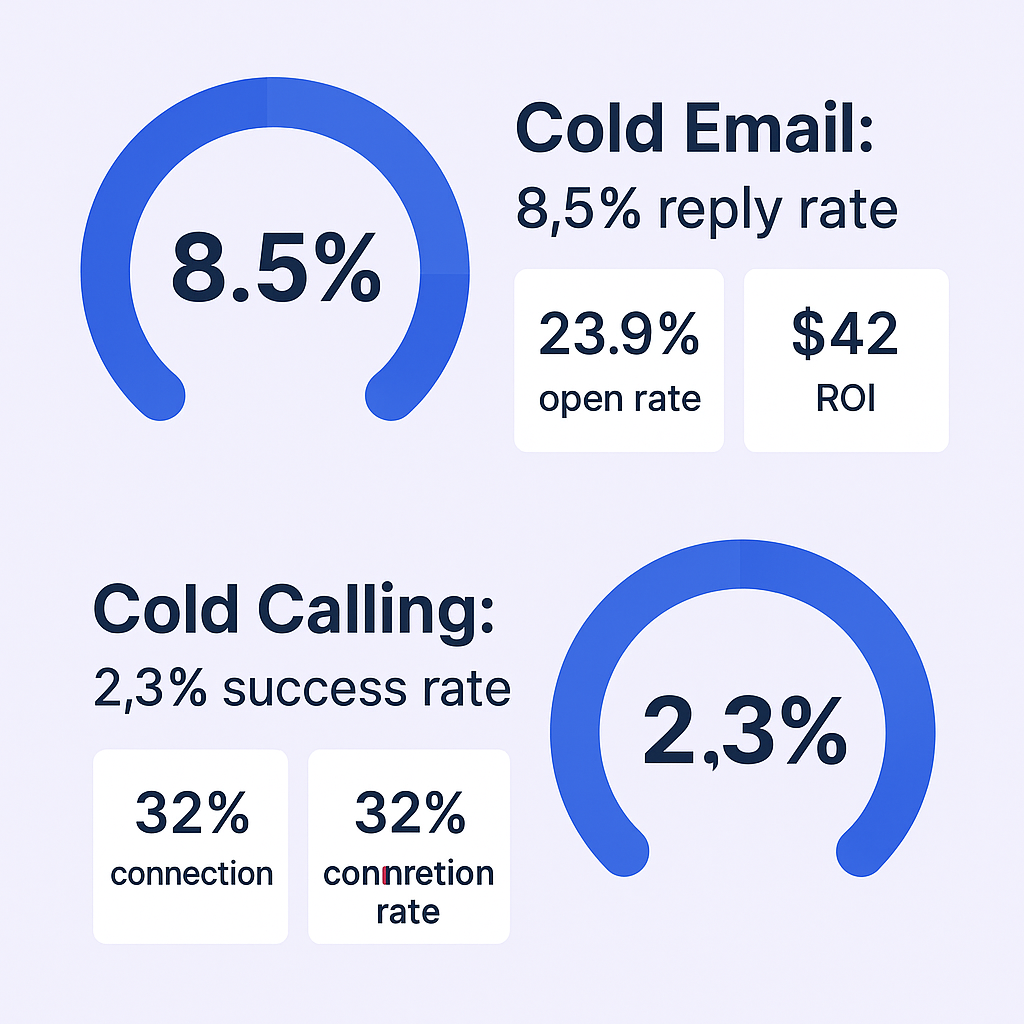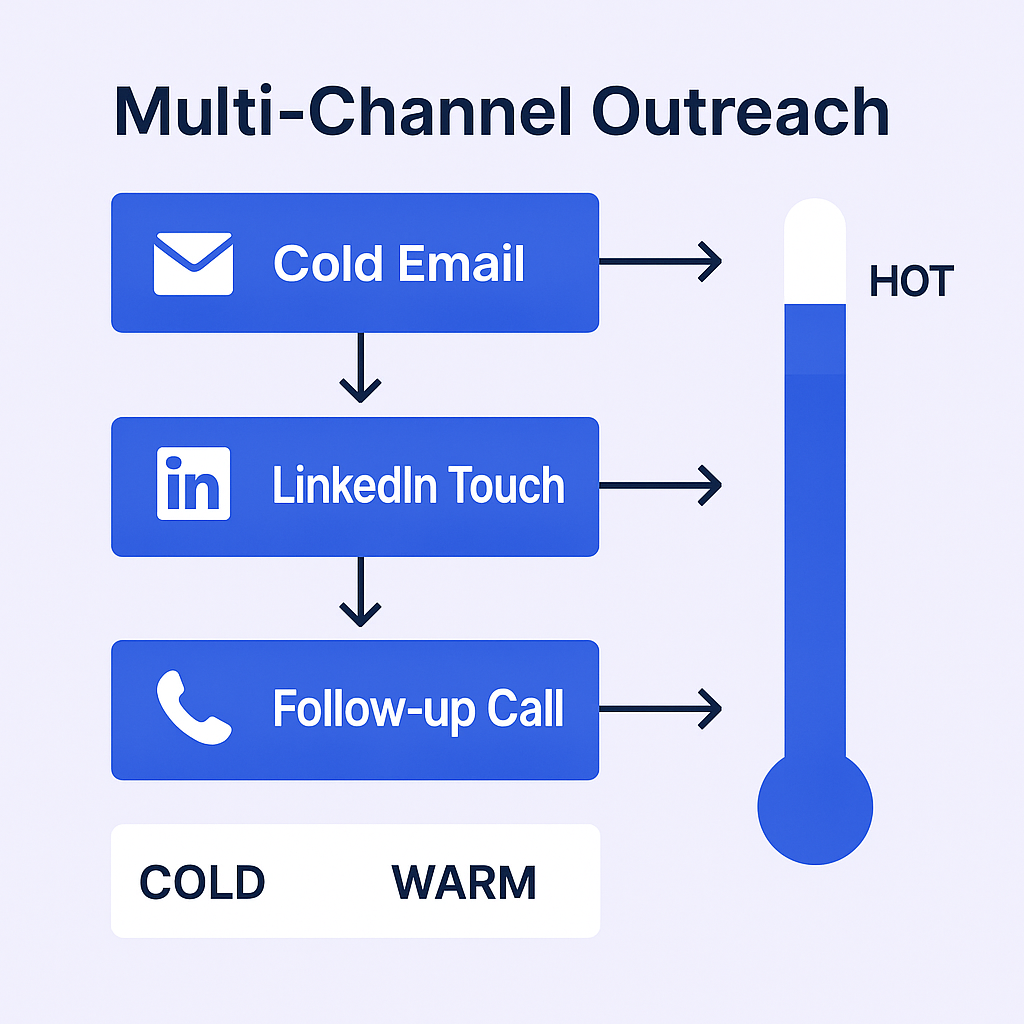- blog
- Email Deliverability
- Cold Calling vs Cold Emailing: Which Strategy Wins in 2025?

Cold Calling vs Cold Emailing: Which Strategy Wins for Sales Professionals in
Table of Contents
When you’re trying to reach potential customers, the age-old debate between cold calling and cold emailing continues to spark conversations in sales teams worldwide. Both strategies have their place in modern sales, but understanding when and how to use each one can make the difference between hitting your quota or falling short.
If you’re a Business Development Representative (BDR) or Account Executive (AE), you’ve probably wondered: “Should I pick up the phone or craft that perfect email?” The truth is, cold emailing and cold calling work best when you understand their unique strengths and how they fit into your overall outreach strategy.
Let’s dive deep into both approaches, examine the latest statistics, and help you decide which method (or combination) will drive the best results for your sales goals.
What is Cold Emailing?
Cold emailing involves sending personalized, unsolicited emails to prospects you’ve never contacted before. Unlike spam, which casts a wide net with generic messages, cold emailing focuses on building genuine business relationships through targeted, one-to-one communication.
For BDRs, cold emailing serves as a fundamental prospecting tool. The average open rate of cold emails is only 23.9%, but when executed properly, it becomes a scalable way to initiate conversations with potential customers across large audiences.
What makes cold emailing different from warm emailing? Cold emails are sent to prospects who have zero prior relationship with your company, while warm emails target recipients who’ve already shown some interest—perhaps by visiting your website or downloading a resource.
The key distinction lies in the intent: cold emailing aims to spark genuine dialogue rather than push for immediate sales. According to a study by Backlinko, the average cold email reply rate is just 8.5%, making personalization and value delivery crucial for success.
What is Cold Calling?
Cold calling means reaching out by phone to prospects who haven’t previously interacted with you or your company. Modern cold calling has evolved far beyond the outdated “smile and dial” approach—today’s successful cold callers conduct thorough research and deliver personalized, value-driven conversations.
Despite digital transformation, cold calling remains powerful. 82% of buyers accept meetings at least occasionally with sellers who reach out to them, and 57% of C-level executives and VPs say they would rather hear from sales reps via the phone than any other channel.
However, the landscape has changed. The average cold calling success rate has dropped to 2.3% in 2025, almost half of what was achieved just 12 months ago. This decline reflects increased competition and changing buyer behaviors, making targeted, research-driven approaches more critical than ever.
The evolution from script to strategy: Today’s effective cold callers focus on understanding prospects’ pain points and delivering solutions rather than following rigid scripts. They use data to identify high-quality leads and personalize their approach for each conversation.
Cold Email vs Cold Call: What Sets them Apart?
The fundamental difference between these two approaches lies in their communication style and interaction timing, which shapes everything from scalability to personal connection.
Feature | Cold Email | Cold Call |
Medium | Written communication via email | Verbal communication over phone |
Interaction | Asynchronous (recipient decides when to engage) | Real-time (immediate feedback) |
Detail Level | High (can include attachments, links, data) | Low (brief, direct conversation) |
Scalability | High (automated, cost-effective for bulk) | Low (resource-intensive per call) |
Tracking | Comprehensive (opens, clicks, replies) | Limited (contacted, responded) |
Intrusiveness | Low (less disruptive to daily activities) | High (can interrupt workflow) |
Personal Touch | Requires deliberate effort and research | Inherently more personal due to live voice |
The core distinction is asynchronous versus synchronous communication. Cold email campaigns offer convenience and high scalability because recipients engage at their leisure, allowing broader reach. Conversely, making cold calls provides immediate interaction and deeper personal connection, enabling real-time conversation adaptation.
This difference isn’t just about preference—it’s a strategic decision based on your prospect’s communication style, availability, and the complexity of your message. Simple, straightforward messages work well via email, while complex solutions requiring immediate clarification benefit from phone conversations.
What are the Pros and Cons of Cold Emailing?
Pros of Cold Emailing
Scalability and Cost-Effectiveness Cold emailing shines when it comes to reaching large audiences efficiently. Cold email marketing has a 2x higher ROI than cold calling or trade shows, with the ROI of a cold email is $42 for every $1 spent.
This efficiency multiplier is crucial for BDRs whose primary role involves filling the sales pipeline with opportunities. You can send hundreds of personalized emails daily using automation tools, making it ideal for broad lead generation phases where volume and efficiency are paramount.
Recipient Convenience and Flexibility Unlike phone calls, cold emails respect your prospect’s time and schedule. 80% of people prefer to be contacted by sales reps through email. Recipients can read and respond when it’s convenient for them, leading to higher open and response rates because prospects don’t feel pressured or interrupted.
Detailed Information and Trackable Metrics Cold emails allow for comprehensive explanations of your product or service, customer success stories, supporting data, and relevant attachments. Modern email tools provide extensive tracking capabilities, including open rates, click-through rates, and response rates, enabling data-driven strategy improvements.
💡 Skip Cold Outreach. Go Professional
LinkedIn outbound connects with decision-makers actively networking, not hiding from sales calls
7-day Free Trial |No Credit Card Needed.
Cons of Cold Emailing
Lack of Immediate Attention and Deliverability Issues Digital inboxes are crowded spaces where cold emails from unknown senders often get overlooked, deleted, or filtered into spam folders. The average cold email bounce rate is 7.5%, and frequent cold emailing with pushy or spammy language can trigger spam filters.
The lack of personalization directly contributes to deliverability issues because generic emails are more likely to be flagged as spam. When emails land in spam folders, they don’t get opened, creating a cycle where poor personalization leads to poor results.
Limited Personalization and Conveying Complexity Sending generic cold emails without adequate personalization significantly reduces effectiveness, often leading to emails being ignored or marked as spam. Personalized email content increases average cold email response rates by 32.7%.
Additionally, explaining complex products or services within a short email can be challenging. If the message is too dense or not engaging enough, prospects may become confused and simply delete the email.
Legal and Compliance Hurdles Cold emailing is subject to various anti-spam regulations like the CAN-SPAM Act in the US and GDPR in Europe. Non-compliance can result in substantial fines and damage to your company’s reputation, adding complexity that sales professionals must navigate carefully.
What are the Pros and Cons of Cold Calling?
Pros of Cold Calling
Real-Time Two-Way Communication and Voice Cues The primary advantage of cold calling lies in immediate, live conversations. Prospects can ask questions and voice concerns instantly, fostering understanding and trust that’s difficult to achieve through email exchanges.
During calls, sales professionals can listen to voice tones and adapt responses in real-time based on immediate reactions. This dynamic interaction allows skilled AEs to navigate complex conversations and build trust much faster than through asynchronous email exchanges.
Immediate Feedback and Relationship Building Cold calling provides instant feedback, enabling salespeople to quickly adapt their approach and uncover roadblocks immediately. Direct conversation allows sales professionals to convey excitement, energy, and genuine passion for their product or service, which can be far more compelling than written words.
This human connection is particularly vital for complex sales cycles where establishing trust and understanding is paramount.
Quick Conveyance of Simple Messages For straightforward offerings that are easy to understand, a phone call can efficiently deliver the main message and elicit an immediate reaction. This can often be more efficient than crafting a detailed email, especially when the goal is a quick, concise interaction.
Cons of Cold Calling
Recipient Dislike and Low Response Rates Many individuals find unsolicited cold calls intrusive and disruptive, particularly during busy periods. This often leads to low receptiveness, immediate hang-ups, or calls being redirected to voicemail.
The average cold calling success rate is 2.3% in 2025, representing a significant decrease from previous years. 72% of cold calls are never answered due to incomplete or wrong data, further highlighting the efficiency challenges.
High Cost to Scale and Difficulty Reaching Decision-Makers Scaling cold calling efforts requires substantial investment in human resources, including recruitment, training, workstations, tools, and phone lines. This makes cold calling a heavy financial commitment compared to email’s scalability.
Furthermore, receptionists and administrative assistants frequently act as gatekeepers, filtering calls to protect decision-makers from interruptions. Navigating past these individuals can be a considerable hurdle for sales professionals.
Legal Regulations and Brand Risk Many countries have established rules governing how, when, and whom companies can engage in cold calling, such as the US Do Not Call List and various FTC regulations. Non-compliance can lead to substantial fines and reputation damage.
Additionally, the negative stigma often associated with unsolicited phone calls can potentially harm a brand’s image if prospects feel annoyed or inconvenienced.
What’s the Ideal Success Rate for Cold Emails and Cold Calls?
Understanding typical success rates helps sales professionals set realistic expectations and refine their strategies. These figures vary significantly based on industry, target audience, and execution quality.
Metric | Cold Email | Cold Call |
Average Open Rate | ~23.9% (personalized subject lines boost by 50%) | N/A (not applicable) |
Average Reply Rate | ~8.5% (advanced personalization achieves 17%) | N/A (not applicable) |
Average Success Rate | 1-5% conversion rate | ~2.3% (meetings booked) |
Average Connection Rate | N/A (email is sent) | ~32% (93% by third call) |
Average ROI | $42 for every $1 spent | Lower direct ROI metrics available |

The significant difference in success rates—8.5% average reply rate for cold email compared to 2.3% success rate for cold calls—underscores a critical principle: merely increasing outreach volume without enhancing quality is ineffective.
For making cold calls, the 2.3% success rate means 97.7% of calls do not convert to a warm lead or meeting. This makes each successful call exceptionally valuable, highlighting the imperative for high-quality leads and skilled sales professionals.
For cold email campaigns, while open rates may be higher, low reply rates still necessitate robust personalization to stand out in crowded inboxes. The focus should be on precision and value in each interaction rather than sheer volume.
How to Boost Your Cold Email Success Rate?
While average success rates might seem challenging, significant potential exists for those who adopt effective strategies. Success requires a multi-layered approach from technical setup to content strategy and persistence.
Personalization Techniques
Deep personalization goes beyond using a prospect’s name. Mention specific details about their work, recent achievements, company news, or industry trends. Personalized emails of a cold email boost response rate by 30.5%, and personalized email subject lines boost open rates by 50%.
The message must directly connect to their needs, challenges, or interests. Leveraging AI tools can assist in analyzing public data to suggest unique talking points, making personalization at scale more efficient.
Subject Line Best Practices
The subject line often determines whether an email gets opened. It should be catchy and concise, ideally between 36-50 characters for optimal performance. Questions in subject lines get a 21% increase in email open rates, and cold email subject lines including numbers get approximately 113% more email opens.
Avoid spam triggers like all caps, excessive punctuation, or overly promotional words like “Free,” “Act now,” or “Urgent.”
Crafting Compelling Body Copy and CTAs
The body should be short and scannable, ideally between 50-125 words for highest response rates. Use short paragraphs (2-3 lines) and bullet points to enhance readability. Lead with the prospect’s challenges and explain how your solution directly benefits them.
“Interest CTAs” has a success rate of 30%, double the success rates of any other type of CTAs. Low-commitment, interest-based CTAs like “Worth a chat?” or “Curious to see how?” perform better than aggressive sales pitches.
Deliverability and Technical Setup
Ensure cold email deliverability through proper technical setup. New domains and mailboxes should be warmed up gradually. Email addresses must be verified to reduce bounce rates and improve deliverability.
Implement email authentication protocols like SPF, DKIM, and DMARC to verify sender identity and improve inbox placement. 81% of emails are opened on mobile, making mobile optimization crucial.
Follow-Up Strategies
Persistence is key in successful cold email campaigns. Email sequences with multiple attempts can boost response rates by up to 160%. Plan for 4-9 follow-up emails spaced out over several days or weeks.
Each follow-up should provide new value or a different perspective, avoiding mere “checking in” messages. “Break-up emails,” typically the final message in a sequence, can often elicit a response by creating urgency.
How to Boost Your Cold Call Success Rate?
While making cold calls can be challenging, implementing strategic techniques can significantly improve outcomes, transforming initial connections into valuable opportunities.
High-Quality Lead Sourcing and Research
Investing in high-quality, accurate, and up-to-date leads is vital for successful cold calling. Quality data can increase conversion rates by up to 75%. 82% of top-performing salespeople conduct research before making calls.
Sales teams should prioritize targeted prospecting, focusing on prospects that align with their Ideal Customer Profile (ICP). Thorough research into a prospect’s company, challenges, industry trends, and identifying the right contacts is essential.
Optimal Timing and Persistence
Timing plays a crucial role in cold calling success. Tuesday and Wednesday generate 44% of all demos, and the best times to call are between 11 AM – 12 PM and 4 PM – 5 PM.
Persistence is critical: it takes an average of 8 call attempts to reach a prospect, and 80% of successful sales require five or more follow-ups. 60% of customers say “no” four times before agreeing.
📞Better Than 8.5% Email Response
LinkedIn outbound consistently books meetings while cold outreach hopes for replies
Effective Opening Lines and Scripts
A strong opening can make or break a cold call. Acknowledge the interruption immediately: “I know I caught you out of the blue—do you have 27 seconds?” This demonstrates respect for the prospect’s time.
Starting a cold call with the question “How have you been?” can make the pitch more personal, which has been proven to improve success rates significantly. Using this simple phrase in cold calls increases the conversion rate by 6.6 times.
State a clear reason for the call quickly. Salespeople who provide their reason for calling are 2.1 times more successful in booking meetings.
Objection Handling Techniques
Anticipate and prepare for common objections like “not interested,” “no budget,” or “already have a solution.” Empathize with the prospect’s concern before pivoting with a question to understand their perspective or highlight ROI.
Focus on demonstrating value and differentiation, showing how your product can save money, generate revenue, or offer unique advantages.
Follow-Up Strategies
Consistent follow-up calls are essential. It can take at least five follow-up calls to convert a prospect into a lead. A multi-channel approach, combining cold calls with cold emails and social media interactions, helps maintain top-of-mind awareness and increases engagement likelihood.
When Should You Use Cold Emailing?
Cold emailing serves as a versatile tool for broad, strategic outreach, proving particularly effective in specific scenarios where its inherent advantages align with sales objectives.
When Scalability is Key If your goal is reaching potential customers across a large audience efficiently, cold email is the preferred method. It allows sales teams to contact thousands of prospects at a fraction of the time and cost associated with individual cold calls, making it ideal for BDRs aiming to rapidly fill the sales funnel.
When a Less Intrusive Approach is Desired Cold emailing is significantly less intrusive than cold calling. Prospects retain flexibility to decide when they open and read emails, respecting their time and schedule. This makes it excellent for initial contact, especially when avoiding catching prospects off guard.
When Detailed Information Needs to be Conveyed The email format allows for detailed messages, comprehensive explanations, customer success stories, supporting data, and attachments or links. This capability is invaluable for introducing complex products or services, providing essential context, or showcasing value propositions before live conversations.
For Initial Outreach and Nurturing Cold email excels at introducing companies or products to broad audiences. BDRs can effectively use it to spark initial interest, qualify leads, and lay groundwork for subsequent discussions. It’s also highly effective for nurturing leads over time and building brand awareness.
When Targeting Hard-to-Reach Decision-Makers In industries where direct phone engagement with decision-makers is challenging, cold email can be more effective. It often bypasses gatekeepers, allowing messages to land directly in decision-makers’ inboxes, even if read at more convenient times.
Cold email serves as the ideal “first touch” for efficiency and context. Its strengths—scalability, lower intrusiveness, and rich detail—enable BDRs to efficiently qualify leads and provide necessary context before more resource-intensive cold calls.
When Should You Use Cold Calling?
Cold calling is a high-impact strategy best reserved for situations demanding immediate, personal engagement, particularly when stakes are elevated.
When Immediate Response or Feedback is Critical For situations requiring quick answers, real-time feedback, or immediate assessment of prospect interest, cold calling is superior. It provides direct feedback, enabling sales professionals to adapt their approach on the spot. This immediacy is particularly crucial for AEs operating in high-stakes sales environments.
For Complex Sales and Building Strong Rapport Cold calling inherently facilitates more personal connections, indispensable for complex sales where trust and deep understanding are paramount. Hearing a real voice makes conversations feel more genuine and allows for nuanced communication difficult to replicate through written text.
AEs frequently utilize cold calls for in-depth discovery, aiming to fully comprehend prospects’ intricate needs, pain points, and overarching goals.
To Uncover and Handle Objections in Real-Time During cold calls, sales professionals can immediately address concerns related to pricing, timing, features, or competitive offerings. This dynamic interaction allows for immediate trust building and buying friction reduction—a core skill for AEs.
For Deeper Qualification and Discovery While BDRs might use calls for initial qualification, AEs leverage them for in-depth discovery meetings to thoroughly understand prospect needs, pains, and goals. The ability to ask probing questions and listen actively is invaluable here.
When Engaging High-Value Prospects or Specific Referrals For the most valuable prospects or when warm referrals are involved, direct cold calls can be significantly more impactful. They demonstrate commitment and prioritize personal relationships, crucial for securing high-value deals.
Cold calling functions as a “conversion accelerator.” Its strengths—immediacy, real-time feedback, objection handling, and personal connection—make it ideal for AEs. 20% of qualified leads convert into a sale after a cold call.
Can Cold Emailing and Cold Calling Work in Harmony?
The notion of competition between cold emailing and cold calling is a misconception. The most effective sales strategies embrace a multichannel approach, where these powerful tools complement each other to create seamless, highly effective outreach sequences.
The synergy between cold email campaigns and making cold calls, often integrated with social media interactions, significantly enhances chances of connecting with prospects and improving overall engagement. This diversified strategy acknowledges that different buyers have varying communication preferences.
A common and highly effective sequence involves initiating contact with personalized cold emails, followed by targeted cold calls. The initial email provides essential context, and subsequent calls serve as direct follow-ups, increasing likelihood of prospect recognition and receptiveness.
Best Practices for Combined Approaches:
Email First, Then Call: Use cold email to introduce value propositions, share detailed information, and effectively warm up prospects. If prospects open emails or click links, follow-up calls become significantly more targeted and less “cold.”
Contextual Calls: When initiating cold calls, reference recently sent emails. Phrases like “I just sent an email about X, did you get a chance to see it?” provide immediate context and make calls less intrusive.
LinkedIn Touches: Integrate LinkedIn messages or connection requests into sequences. After sending emails, LinkedIn connection requests referencing emails can be sent.
Data-Driven Handoff: BDRs can leverage cold emails to qualify leads and gauge initial interest, subsequently handing off these “warm” leads to AEs for deeper engagement via cold calls.
Automation Where Possible: Utilize tools that integrate both email and calling features to automate follow-ups and track interactions across all channels, streamlining entire outreach processes.
🚀No More Cold Outreach
LinkedIn outbound reaches professionals expecting business conversations, not avoiding them
The harmony between cold email and cold calling is best understood as a “warm-up and convert” pipeline strategy. Cold email, with its scalability and lower intrusiveness, excels at initial “warm-up” phases, providing context and gauging preliminary interest. Cold calling, with its immediacy and personal touch, becomes the “conversion” tool for prospects who’ve already been warmed up.
Final Verdict!
The discussion of cold calling versus cold emailing isn’t a zero-sum game where one method definitively outperforms the other. Instead, maximizing outreach success hinges on understanding their distinct strengths and weaknesses, and crucially, how to integrate them for synergistic results.
Cold emailing is the preferred method for achieving scale, driving efficiency, and delivering detailed information. It’s less intrusive, allowing prospects to engage on their terms, and consistently demonstrates high return on investment. For BDRs, cold emailing is an excellent tool for casting wide nets, qualifying leads, and providing initial context to large audiences.
Cold calling is unparalleled for immediate, personal interaction, enabling sales professionals to understand subtle voice cues and handle objections in real-time. It’s essential for AEs when objectives involve building deep rapport, conducting comprehensive discovery, and accelerating conversions. The ability to engage in warm call scenarios, where prior email interaction has warmed up prospects, significantly enhances phone outreach effectiveness.
The true secret to optimizing outreach success in 2025 lies in adopting strategic, multi-channel approaches. Begin with meticulously crafted, personalized cold emails to warm up prospects and provide relevant context. Subsequently, follow up with targeted cold calls to establish deeper connections, address questions, and advance conversations.
By prioritizing high-quality leads, implementing deep personalization, and maintaining persistent, value-driven follow-ups across both channels, sales professionals can effectively reach potential customers and ensure prospects quickly grasp value propositions, eliminating the need to search for further information.
Better Than 2.3% + 8.5%
LinkedIn outbound delivers superior results than combining cold calling and emailing efforts
How does LinkedIn outbound compare to cold calling and cold emailing for B2B prospecting?
Q: Which is better for generating new leads: cold email or cold calling?
Q: How many follow-ups should be sent or made?
Q: What is the biggest mistake sales professionals make in cold outreach?
Q: How does data quality impact cold outreach success?

Why Choose? LinkedIn Outbound Beats Both
LinkedIn outbound delivers better results than cold calling or emailing with professional networking
